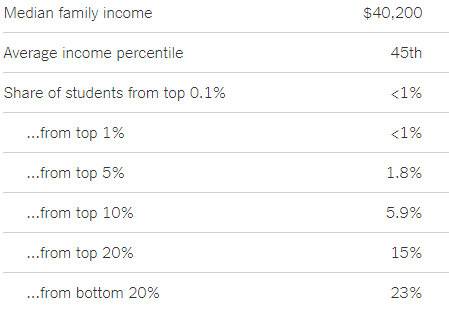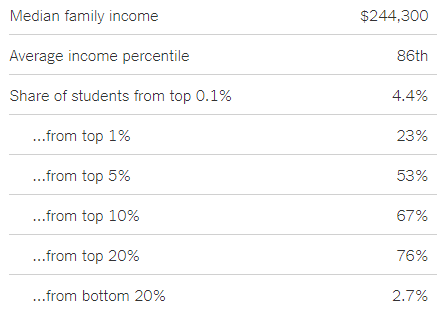I can’t speak to the difference as my S22 never really got access to Naviance (they just use these systems with juniors and seniors) - they phased it out during his sophomore year. I think SCOIR is pretty user friendly - a new function this year is that you can show admissions results in a list format as well as via scattergram. Sometimes it is easier to read that way (for very popular schools with lots of applicants).
I haven’t noticed that feature. Where is it?
Though it could be that out school didn’t turn it on. I believe SCOIR is pretty customizable on the school’s end.
On our version when you hit the “view application scattergram” there are two little icons on the upper right hand side of the page - one is for the scattergram and if you click the other one it will show the data in list format. They didn’t have that function last year.
Thanks. I’ll take a look!
My DS has pretty good GPA and test score but weak with his leadership positions and wonder how he will do for some what selective schools (not ivies). All the stuff you read on CC about ECs it seems like they are pretty important.
I think they are important, but not in the way you often see here.
IMO if you have a single leadership position in something you really like and can show passion and commitment too, it can go a long way. Too many kids water themselves down by trying to have a hand in everything. It becomes a laundry list of check boxes.
Also, leadership can be shown through action. He should try and “actionalize” (and quantify if appropriate) his activity description, not just list it.
It depends on what schools your son is looking at and what application. Most schools have information on their website about what they are looking for (Google “school name admissions what we are looking for”). Tell him to look at what is posted on a school’s admissions You Tube channel and follow schools’ social media posts (Twitter, Instagram, Facebook). Tell him not to use the same activities/essays for all schools. Find out what each school looking for and tell them why/how he is that student.
The UC application has more room for students to expand on what they have done, than the Common App. As an example, in this video, Berkeley admissions tells what they are looking for when it comes to extracurricular activities and leadership. Note that each UC is its own university with its own admissions department. Each UC evaluates applications differently. If applying to UCs, it is important to look up what each individual university is looking for.
I now think about ECs very differently than I did before diving into college admissions a few years ago with D22. My uninformed perception had been that colleges were seeking the most accomplished students, and thus they wanted to see lots of accomplishments - the more, the better.
But now, after going all the way through the admissions process and spending countless hours reading books/scouring CC/listening to YCBK/etc. and observing the experiences of many others, I think colleges aren’t just sizing up the volume of impressive things in an application. Rather, they want to see that a student is passionate about something (may or may not be school-related), and they want to understand how that passion (1) has impacted the student’s community already, (2) will impact their campus in the next four years, and (3) will impact the world thereafter. If a student can do that, I think they have done everything you can reasonably do with extracurriculars on an application. My two cents.
I am going to cut to the chase here. Leaving out state flagships (public ivies and such) and the very tippy top lottery schools, the biggest advantage in college admissions in the power to pay full fare along with choice of major.
Don’t worry so much about leadership etc. Most of these selective LACs/universities >50% of students are full pay. And some schools like Northeastern and Wake Forest lead the pack. Strategize, figure out what your budget is and then ED (both ED1/2). You will be fine.
For the love of sanity, do not apply to an impacted major – CS, economics, business, data science, film, biology, neuroscience, some engineering disciplines etc. if you can. This depends on the school. So, do your research on common datasets available for each school and see what the most popular majors are.
The parents that get screwed are those with budgets in the $30-40K range and think their standard strong kids (1450+SAT, 4.3+ GPA, 6-8 APs) are special. They are not. Sorry, hate to break it to you.
Is there data that shows this?
Yes. Look up common datasets and ed acceptance rates. Even at the very top schools, ED provides a distinct advantage. I worded my sentence incorrectly. What I meant to say is that >50% of accepted students are full pay.
I dont think full pay itself helps with ED unless you have some other hook like legacy or recruited athlete.
If you are unhooked and full pay, it probably doesnt provide that much of an advantage, if at all. The greater emphasis is the hooked part, not the full pay.
I respectfully disagree. Almost all colleges have revenue targets. Hook is always helpful, but only absolutely important for some schools where admission is a lottery.
Here is a beautiful essay on the topic from a SLAC:
https://www.union.edu/admissions/school-counselors/resources/needblind-needaware
You are free to look up ED/RA rates for schools.
Schools that are nearly 50% TO and >50% full pay have revenue targets. Believe what you must.
Here is another great blog entry that you should read:
Opportunities Insights, housed at Harvard, produced College Mobility Report Cards. When the link for the report cards is clicked it leads to this page where the data was used at The New York Times. In the top right hand box you can type the name of any school you are interested in. (The default appears to be City College of New York.)
This are some of the family income data for City College of New York:

Here are the same data for Middlebury:

I’ve seen these numbers for years and I can’t cite internet sources, just word of mouth, but I can assure you that full pay families get dropped by colleges when their student’s metrics are above or below the middle 50 even when they express interest. I’m sure it doesn’t happen to everyone to whom this applies, but it does happen.
The metrics you are citing are not enough to ensure wide admissions benefits to full pay families at need aware schools. There are very, very few “need-blind” schools. At best, it might fall under the considered column but at a level less than the traditional hooks that are considered, particularly in areas with a relatively high concentration of high-income families with high EFCs.
I agree - huge advantages in being full pay. However, an overwhelming majority of us will find it hard to dole out 360K over 4 years for any school. I was playing if - then games in my mind and if Wake Forest and in-state (U-Mich, UW-Madison, UC Riverside (LA and Cal would be no brainers) then what would be the choice. It is not really easy unless the $250-360K is something that is an easy spend.
This is really helpful. Is there a way to filter down to just the data from the last year or two? Ours seems to start with several years…which is useless past last year or so when combined together.
Yes, if you look at the top left under “Application Analysis” there should be 3 buttons - application type, class year and weighted gpa. Under the class year you can narrow down the range. I usually look at the past 2 years (ours isn’t updated for class of '23) - longer if the school isn’t that popular and doesn’t have a lot of data points.
’ve seen these numbers for years and I can’t cite internet sources, just word of mouth, but I can assure you that full pay families get dropped by colleges when their student’s metrics are above or below the middle 50 even when they express interest. I’m sure it doesn’t happen to everyone to whom this applies, but it does happen.
That’s why I said to use ED. Show intent and they will accept. FYI, Lafayette accepts ~50% of ED applicants. It is a selective and popular LAC.
I agree - huge advantages in being full pay. However, an overwhelming majority of us will find it hard to dole out 360K over 4 years for any school. I was playing if - then games in my mind and if Wake Forest and in-state (U-Mich, UW-Madison, UC Riverside (LA and Cal would be no brainers) then what would be the choice. It is not really easy unless the $250-360K is something that is an easy spend.
For perspective, there are about 10 million families in the US that make more than $250K. The schools that everyone applies to are not hurting for full pay kids. Of the schools you have listed, I can assure you that Michigan and Madison are not hurting for full pay kids. Hence, look for financial and academic safeties early in the game. And then, there are enough parents and kids that think taking out large loans to attend a “prestigious” college is a fine idea. YMMV.
A lot of ED applicants fit into categories that are not necessarily full pay but are priority spots in a small LAC class. LACs are looking to fill certain categories and that can leave certain students in overrepresented groups out of luck. It’s not a reflection of them or their abilities so much as it is an artificial scarcity situation. Seats at that one LAC are scarce, but if you consider seats at comparable schools, they are not scarce. What moves the needle into the acceptance column for one student is rarely if ever the full-pay thing. For the vast majority of the full-pay crowd, it doesn’t make a meaningful difference.

